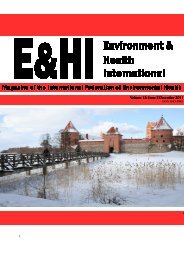ISSN 1683-3805
E&HI Volume 11, No. 1 2009 - International Federation of ...
E&HI Volume 11, No. 1 2009 - International Federation of ...
- No tags were found...
Create successful ePaper yourself
Turn your PDF publications into a flip-book with our unique Google optimized e-Paper software.
competencies – also known as professional<br />
behaviours (not encompassing a code of ethics)<br />
which partly frame the way you operate in<br />
working life, whereupon practitioners assume<br />
a status of being ‘capable’ i.e. they have been<br />
set on the road to achieving competence. It is<br />
the progression through these stages that is<br />
normally delivered via the EHP qualification<br />
process. On-going development into a competent<br />
practitioner occurs via the addition of<br />
work-based experience, reflective learning<br />
and peer assessment with further development<br />
to a state of ‘excellence’ also being possible.<br />
4.8 The model detailed above was accepted<br />
by IFF in Brisbane who additionally saw<br />
knowledge, skills and competencies as conferring<br />
an ability within practitioners to identify,<br />
assess and manage risks to (public) health<br />
that arise from the impact of a range of stressors<br />
on our world. This ability was regarded as<br />
being a unique feature of those who successfully<br />
complete the EHP educational process<br />
and was subsequently labelled as “EHness”<br />
i.e. those abilities/skills uniquely possessed<br />
and focussed on in professional practice by<br />
EHPs.<br />
4.9 The IFF in Brisbane went on to populate<br />
the first three levels of the staircase<br />
(‘EHness’) as follows; although it should be<br />
noted that IFF renamed ‘Competencies’ as<br />
‘The Method’ for this purpose:<br />
Knowledge<br />
Anatomy physiology and<br />
basic toxicology<br />
The built environment<br />
Skills<br />
Determine and articulate<br />
the nature of a hazard and<br />
quantify the level of risk<br />
associated with that hazard<br />
Plan and execute statistically<br />
reliable sampling programmes,<br />
analyse and interpret<br />
data<br />
Plan, execute and report on<br />
inspections, investigations<br />
and audits<br />
Obtain admissible evidence<br />
and apply due legal processes<br />
Design, implement and<br />
evaluate a research protocol<br />
The Method<br />
Identify and articulate the<br />
range of actual and potential<br />
biological, chemical, physical,<br />
social and psychosocial<br />
stressors that may act upon<br />
and within the physical,<br />
social and human worlds<br />
Identify and articulate the<br />
points of possible impact of<br />
the stressors on and within<br />
the worlds<br />
Identify and articulate the<br />
mechanism of impact of the<br />
stressors on and within the<br />
worlds<br />
Identify and articulate the<br />
potential and actual public<br />
health implications that<br />
(may) arise from the impact<br />
of stressors on and within<br />
the worlds<br />
Identify and articulate the<br />
points at which EHPs may<br />
intervene to prevent, control<br />
or mitigate the impact of<br />
stressors on and within the<br />
worlds<br />
Determine appropriate<br />
courses of action<br />
Organise self and work<br />
within organisations<br />
Demonstrate effective communication<br />
skills<br />
Become a reflective practitioner<br />
Work with and within communities<br />
Identify, communicate and<br />
engage with partner organisations,<br />
agencies, fellow<br />
professionals and others<br />
with whom appropriate<br />
intervention strategies<br />
might need to be formulated<br />
Identify and articulate the<br />
most appropriate intervention<br />
to exercise, having<br />
regard to the factors, be<br />
they political, financial and<br />
technological that are likely<br />
to influence the decision<br />
making process<br />
Design and implement appropriate<br />
intervention<br />
strategies in collaboration<br />
with others<br />
Monitor and review the<br />
effectiveness of the intervention<br />
strategy; altering or<br />
adapting it, where necessary,<br />
according to the actual<br />
or predicted outcome<br />
Social, physical and natural<br />
sciences<br />
Communicable and noncommunicable<br />
diseases –<br />
vectors and control mechanisms<br />
(surveillance and<br />
control)<br />
Research methods<br />
Risk<br />
assessment/<br />
management principles<br />
Principles of pest control<br />
and management<br />
The principles of pollution<br />
prevention and control<br />
Health protection measures<br />
and methods<br />
Inequalities in health<br />
Principles of sustainable<br />
development<br />
Legal principles and processes<br />
29<br />
5.0 ‘EHness’ as the international core curriculum<br />
5.1 Having identified ‘EHness’ as the baseline<br />
knowledge skills and method that enables<br />
EHPs to identify, assess and manage risks to<br />
(public) health that arise from the impact of a<br />
range of stressors on our world means, IFF<br />
accepted that the concept of EHness would



